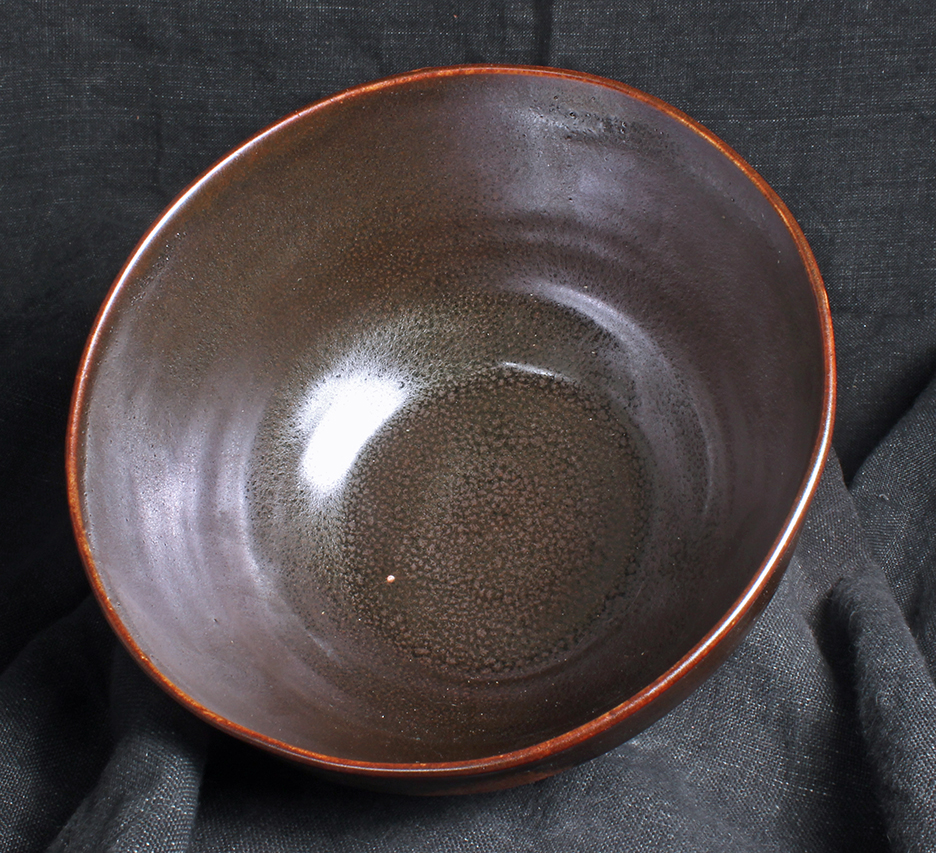Interacting glazes at a vertical interface
Glazes interacting at a vertical interface.
The matrix (i.e. background) glaze and inlay glaze do not overlap before
firing.
The matrix glaze is a microcrystalline matte, as is seen in the image of the bowl.
The inlay glaze
This same inlay glaze is seen
here, as inlay in a related yet distinct microcrystalline matte
glaze.
Several closeups of the interaction region of the two glazes are shown and,
for context,
The background glaze is longquan-shino, the inlay design is
glazed with iron_Alex_1MFe
The design is created by adhering a mask and then applying the main
glaze. After drying,
150 deg F an hour to 250 deg F
400 deg F an hour to 1800 deg F
300 deg F an hour to 2050 deg F
120 deg F an hour to 2310 deg F with a hold of 20 minutes at 2310 deg F
300 deg F an hour to 1900 deg F then a two hour hold at 1900 deg F
50 deg F an hour to 1750 deg F then a one hour hold at 1750 deg F
300 deg F an hour to 1700 deg F then a Three hour hold at 1700 deg F
25 deg F an hour to 1650 deg F then a one hour hold at 1650 deg F
K2O 0.12
Al2O3 0.84
SiO2 3.9
molecular percent Silica 65.7%
K2O 0.07
Al2O3 0.53
SiO2 2.97
molecular percent Silica 64.6%
The original inlay, as placed in the kiln, was a simple curve, about 3/8th of
an inch thick.
The matrix glaze here, longquan-shino, has significantly higher silica than
longquan-iron-shino-Z38-0,
also is a microcrystalline matte. It is seen
here with higher iron.
note the difference in appearance of the interaction region.
a picture of the pot.
the mask is removed and the open area filled in with a
second glaze, using a bulb syringe
with a needle applicator.
Close up Images of the interaction region




Image of the piece

bowl with glaze longquan-shino and inlay glaze
iron_Alex_1MFe.

inside of bowl
bowl is ~7 inches in diameter
oxidation firing to cone 10 in an electric kiln
Firing profiles
Up Fire profile
Down Fire Profile
Clay body is a grolleg porcelain from Tacoma Clay Art Center.
glaze compositions
Background glaze
Empirical Formula longquan-shino :
Na2O 0.45
Li2O 0.18
CaO 0.14
MgO 0.11
Fe2O3 0.20
Inlay Glaze
Empirical Formula iron_Alex_1MFe:
Na2O 0.34
Li2O 0.11
CaO 0.37
MgO 0.11
Fe2O3 0.08
P2O5 0.02
Remarks
The jiggies and jaggies were created by the interaction.
the matrix glaze on the mug previously linked above.
Though longquan-shino has lower Alumina,
it is a significantly
stiffer glaze which accounts for the less flamboyant interaction region on the
bowl.
There is less growth of variant crystals in longquan-shino.